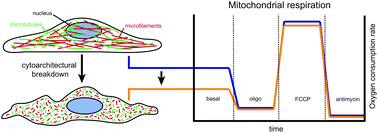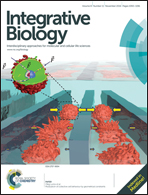Mitochondrial respiration is sensitive to cytoarchitectural breakdown†
Abstract
An abundance of research suggests that cellular mitochondrial and cytoskeletal disruption are related, but few studies have directly investigated causative connections between the two. We previously demonstrated that inhibiting microtubule and microfilament polymerization affects mitochondrial motility on the whole-cell level in fibroblasts. Since mitochondrial motility can be indicative of mitochondrial function, we now further characterize the effects of these cytoskeletal inhibitors on mitochondrial potential, morphology and respiration. We found that although they did not reduce mitochondrial inner membrane potential, cytoskeletal toxins induced significant decreases in basal mitochondrial respiration. In some cases, basal respiration was only affected after cells were pretreated with the calcium ionophore A23187 in order to stress mitochondrial function. In most cases, mitochondrial morphology remained unaffected, but extreme microfilament depolymerization or combined intermediate doses of microtubule and microfilament toxins resulted in decreased mitochondrial lengths. Interestingly, these two particular exposures did not affect mitochondrial respiration in cells not sensitized with A23187, indicating an interplay between mitochondrial morphology and respiration. In all cases, inducing maximal respiration diminished differences between control and experimental groups, suggesting that reduced basal respiration originates as a largely elective rather than pathological symptom of cytoskeletal impairment. However, viability experiments suggest that even this type of respiration decrease may be associated with cell death.



 Please wait while we load your content...
Please wait while we load your content...